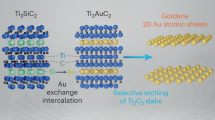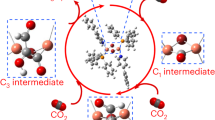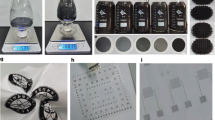Abstract
Ammonia, one of the most important synthetic feedstocks, is mainly produced by the Haber–Bosch process at 400–500 °C and above 100 bar. The process cannot be performed under ambient conditions for kinetic reasons. Here, we demonstrate that ammonia can be synthesized at 45 °C and 1 bar via a mechanochemical method using an iron-based catalyst. With this process the ammonia final concentration reached 82.5 vol%, which is higher than state-of-the-art ammonia synthesis under high temperature and pressure (25 vol%, 450 °C, 200 bar). The mechanochemically induced high defect density and violent impact on the iron catalyst were responsible for the mild synthesis conditions.
This is a preview of subscription content, access via your institution
Access options
Access Nature and 54 other Nature Portfolio journals
Get Nature+, our best-value online-access subscription
$29.99 / 30 days
cancel any time
Subscribe to this journal
Receive 12 print issues and online access
$259.00 per year
only $21.58 per issue
Buy this article
- Purchase on Springer Link
- Instant access to full article PDF
Prices may be subject to local taxes which are calculated during checkout




Similar content being viewed by others
Data availability
The data that support the findings of this study are presented in the main text and the Supplementary Information, and are available from the corresponding author upon reasonable request.
References
Chen, J. G. et al. Beyond fossil fuel–driven nitrogen transformations. Science 360, eaar6611 (2018).
Mineral Commodity Summaries 2019 (US Geological Survey, 2019); https://prd-wret.s3-us-west-2.amazonaws.com/assets/palladium/production/atoms/files/mcs-2019-nitro.pdf
Myers, R. L. The 100 Most Important Chemical Compounds: a Reference Guide (Greenwood Press, 2007).
Appl, M. Ammonia: Principles and Industrial Practice (Wiley-VCH Verlag GmbH, 1999).
Gong, Y. et al. Ternary intermetallic LaCoSi as a catalyst for N2 activation. Nat. Catal. 1, 178–185 (2018).
Foster, S. L. et al. Catalysts for nitrogen reduction to ammonia. Nat. Catal. 1, 490–500 (2018).
Rodriguez, M. M., Bill, E., Brennessel, W. W. & Holland, P. L. N2 reduction and hydrogenation to ammonia by a molecular iron-potassium complex. Science 334, 780–783 (2011).
Marnellos, G. & Stoukides, M. Ammonia synthesis at atmospheric pressure. Science 282, 98–100 (1998).
Wang, P. et al. Breaking scaling relations to achieve low-temperature ammonia synthesis through LiH-mediated nitrogen transfer and hydrogenation. Nat. Chem. 9, 64–70 (2017).
Mehta, P. et al. Overcoming ammonia synthesis scaling relations with plasma-enabled catalysis. Nat. Catal. 1, 269–275 (2018).
Anderson, J. S., Rittle, J. & Peters, J. C. Catalytic conversion of nitrogen to ammonia by an iron model complex. Nature 501, 84–87 (2013).
Licht, S. et al. Ammonia synthesis by N2 and steam electrolysis in molten hydroxide suspensions of nanoscale Fe2O3. Science 345, 637–640 (2014). retraction 369, 780 (2020).
Gao, W. et al. Production of ammonia via a chemical looping process based on metal imides as nitrogen carriers. Nat. Energy 3, 1067–1075 (2018).
Kitano, M. et al. Ammonia synthesis using a stable electride as an electron donor and reversible hydrogen store. Nat. Chem. 4, 934–940 (2012).
Logadottir, A. et al. The Brønsted–Evans–Polanyi relation and the volcano plot for ammonia synthesis over transition metal catalysts. J. Catal. 197, 229–231 (2001).
Vojvodic, A. et al. Exploring the limits: a low-pressure, low-temperature Haber–Bosch process. Chem. Phys. Lett. 598, 108–112 (2014).
Khorshidi, A., Violet, J., Hashemi, J. & Peterson, A. A. How strain can break the scaling relations of catalysis. Nat. Catal. 1, 263–268 (2018).
Michalsky, R., Avram, A. M., Peterson, B. A., Pfromm, P. H. & Peterson, A. A. Chemical looping of metal nitride catalysts: low-pressure ammonia synthesis for energy storage. Chem. Sci. 6, 3965–3974 (2015).
Wilk, B., Pelka, R. & Arabczyk, W. Study of the iron catalyst for ammonia synthesis by chemical potential programmed reaction method. J. Phys. Chem. C. 121, 8548–8556 (2017).
Swearer, D. F., Knowles, N. R., Everitt, H. O. & Halas, N. J. Light-driven chemical looping for ammonia synthesis. ACS Energy Lett. 4, 1505–1512 (2019).
James, S. L. et al. Mechanochemistry: opportunities for new and cleaner synthesis. Chem. Soc. Rev. 41, 413–447 (2012).
Baláž, P. Mechanochemistry in Nanoscience and Minerals Engineering (Springer-Verlag, 2008).
Suryanarayana, C. Mechanical alloying and milling. Prog. Mater. Sci. 46, 1–184 (2001).
Suzuki, T. S. & Nagumo, M. Metastable intermediate phase formation at reaction milling of titanium and n-heptane. Scr. Metall. Mater. 32, 1215–1220 (1995).
Andersen, S. Z. et al. A rigorous electrochemical ammonia synthesis protocol with quantitative isotope measurements. Nature 570, 504–508 (2019).
Lazouski, N., Chung, M., Williams, K., Gala, M. L. & Manthiram, K. Non-aqueous gas diffusion electrodes for rapid ammonia synthesis from nitrogen and water-splitting-derived hydrogen. Nat. Catal. 3, 463–469 (2020).
Ampelli, C. Electrode design for ammonia synthesis. Nat. Catal. 3, 420–421 (2020).
McEnaney, J. M. et al. Ammonia synthesis from N2 and H2O using a lithium cycling electrification strategy at atmospheric pressure. Energy Environ. Sci. 10, 1621–1630 (2017).
Schiffer, Z. J. & Manthiram, K. Electrification and decarbonization of the chemical industry. Joule 1, 10–14 (2017).
Hao, Y.-C. et al. Promoting nitrogen electroreduction to ammonia with bismuth nanocrystals and potassium cations in water. Nat. Catal. 2, 448–456 (2019).
Honkala, K. et al. Ammonia synthesis from first-principles calculations. Science 307, 555–558 (2005).
Ertl, G. Surface science and catalysis—studies on the mechanism of ammonia synthesis: the P. H. Emmett Award address. Catal. Rev. 21, 201–223 (1980).
Ertl, G. in Catalytic Ammonia Synthesis (ed. Jennings, J. R.) Ch. 3 (Springer, 1991).
Ye, T.-N. et al. Vacancy-enabled N2 activation for ammonia synthesis on an Ni-loaded catalyst. Nature 583, 391–395 (2020).
Moriya, T., Sumitomo, Y., Ino, H., Fujita, F. E. & Maeda, Y. Mössbauer effect in iron-nitrogen alloys and compounds. J. Phys. Soc. Jpn 35, 1378–1385 (1973).
Torres, J., Perry, C. C., Bransfield, S. J. & Fairbrother, D. H. Low-temperature oxidation of nitrided iron surfaces. J. Phys. Chem. B 107, 5558–5567 (2003).
Rao, C. N. R. & Rao, G. R. Nature of nitrogen adsorbed on transition metal surfaces as revealed by electron spectroscopy and cognate techniques. Surf. Sci. Rep. 13, 223–263 (1991).
Chen, J. G. NEXAFS investigations of transition metal oxides, nitrides, carbides, sulfides and other interstitial compounds. Surf. Sci. Rep. 30, 1–152 (1997).
Mårtensson, N. et al. On the relation between X-ray photoelectron spectroscopy and XAFS. J. Phys. Conf. Ser. 430, 012131 (2013).
Tong, W. P., Tao, N. R., Wang, Z. B., Lu, J. & Lu, K. Nitriding iron at lower temperatures. Science 299, 686–688 (2003).
Haynes, W. M. (ed.) CRC Handbook of Chemistry and Physics (CRC Press, 2016).
Mavrikakis, M., Hammer, B. & Nørskov, J. K. Effect of strain on the reactivity of metal surfaces. Phys. Rev. Lett. 81, 2819–2822 (1998).
Kresse, G. & Furthmüller, J. Efficient iterative schemes for ab initio total-energy calculations using a plane-wave basis set. Phys. Rev. B 54, 11169–11186 (1996).
Blöchl, P. E. Projector augmented-wave method. Phys. Rev. B 50, 17953–17979 (1994).
Perdew, J. P., Burke, K. & Ernzerhof, M. Generalized gradient approximation made simple. Phys. Rev. Lett. 77, 3865–3868 (1996).
Henkelman, G., Uberuaga, B. P. & Jónsson, H. A climbing image nudged elastic band method for finding saddle points and minimum energy paths. J. Chem. Phys. 113, 9901–9904 (2000).
Han, G.-F. et al. Dissociating stable nitrogen molecules under mild conditions by cyclic strain engineering. Sci. Adv. 5, eaax8275 (2019).
Acknowledgements
We are grateful for the use of the Pohang Accelerator Laboratory (6D UNIST-PAL beamline, South Korea) and the Mössbauer Effect Data Center (DICP, China). This work was supported by the Creative Research Initiative (CRI, 2014R1A3A2069102) and the Science Research Center (SRC, 2016R1A5A1009405) programmes through the National Research Foundation (NRF) of Korea, the U-K Brand Project (1.200096.01) of UNIST, and the National Natural Science Foundation of China (no. 51631004). S.S. acknowledges support from the University of Calgary’s Canada First Research Excellence Fund programme, the Global Research Initiative in Sustainable Low Carbon Unconventional Resources.
Author information
Authors and Affiliations
Contributions
J.-B.B. conceived the project and oversaw all the research phases. J.-B.B. and G.-F.H. designed the project. H.-J.N. conducted the HRTEM experiments. F.L., Z.F. and Y.L. carried out the soft XANES measurements. S.-J.K. performed the GC measurements. J.-B.B., Q.J. and G.-F.H. conceived the theoretical model. Q.J., S.S., Z.-W.C., C.V.S. and C.C. conducted the theoretical calculations. Data collection and analysis were conducted by J.-B.B. and G.-F.H. All authors discussed the results and commented on the manuscript.
Corresponding authors
Ethics declarations
Competing interests
The authors declare no competing interests.
Additional information
Peer review information Nature Nanotechnology thanks Viktor Colic and the other, anonymous, reviewer(s) for their contribution to the peer review of this work.
Publisher’s note Springer Nature remains neutral with regard to jurisdictional claims in published maps and institutional affiliations.
Supplementary information
Supplementary Information
Supplementary notes, Figs. 1–16, Tables 1–3 and refs. 1–4.
Supplementary Video 1
Video showing a typical ammonia preparation process via mechanochemistry.
Rights and permissions
About this article
Cite this article
Han, GF., Li, F., Chen, ZW. et al. Mechanochemistry for ammonia synthesis under mild conditions. Nat. Nanotechnol. 16, 325–330 (2021). https://doi.org/10.1038/s41565-020-00809-9
Received:
Accepted:
Published:
Issue Date:
DOI: https://doi.org/10.1038/s41565-020-00809-9
This article is cited by
-
A contact-electro-catalysis process for producing reactive oxygen species by ball milling of triboelectric materials
Nature Communications (2024)
-
Hydrogenation of different carbon substrates into light hydrocarbons by ball milling
Nature Communications (2023)
-
Laser-induced nitrogen fixation
Nature Communications (2023)
-
Achieving volatile potassium promoted ammonia synthesis via mechanochemistry
Nature Communications (2023)
-
Analysis of the Scale of Global Human Needs and Opportunities for Sustainable Catalytic Technologies
Topics in Catalysis (2023)



